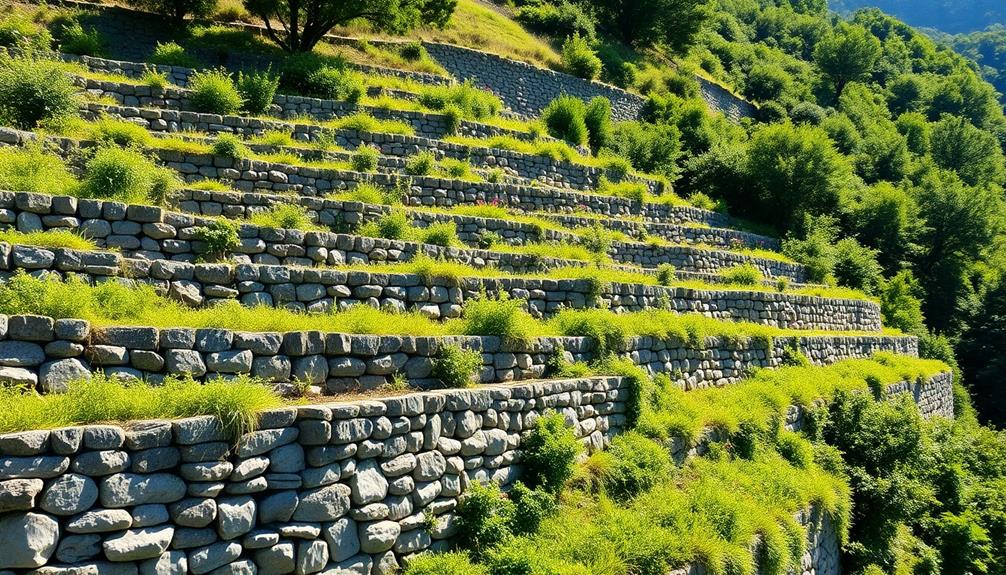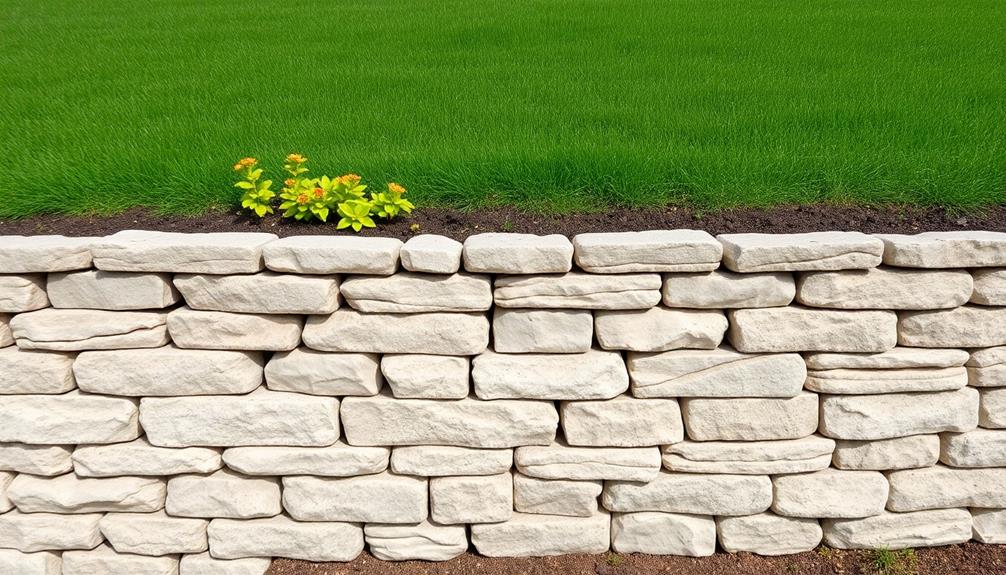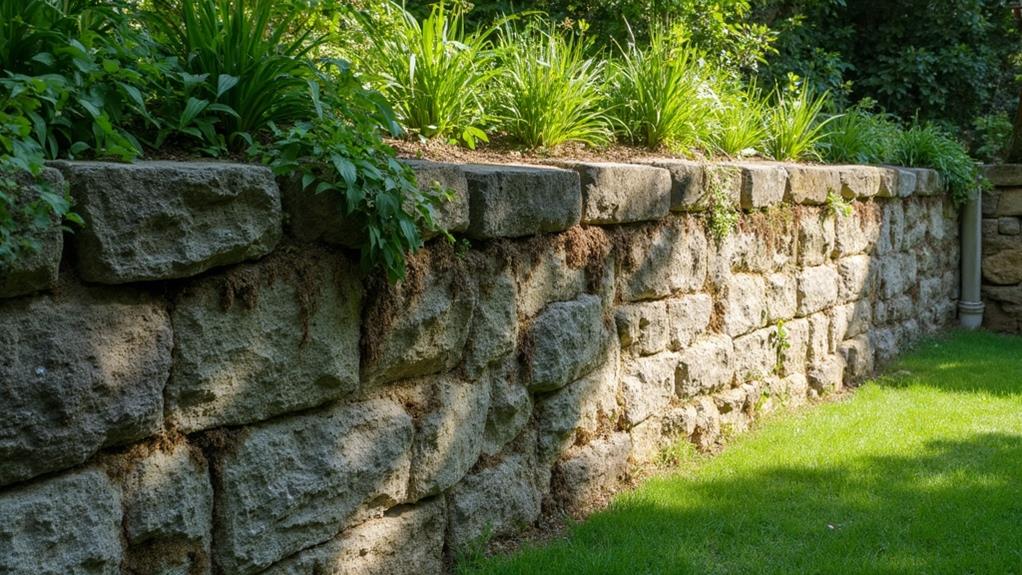Retaining wall maintenance is vital for preserving structural integrity, preventing soil erosion, and maintaining landscape aesthetics. Regular inspections are essential to identify and address issues early, focusing on structural stability, drainage functionality, and vegetation management. Proper maintenance includes clearing debris from drainage systems, controlling plant growth near the wall, and addressing cracks or displacements promptly. Seasonal checks, particularly in spring and fall, help assess weather-related damage and drainage problems. Aesthetic enhancements, such as cleaning and applying protective coatings, contribute to the wall's longevity and visual appeal. Understanding these maintenance aspects guarantees the retaining wall's continued effectiveness and durability, safeguarding your property investment for years to come.
Table of Contents
ToggleWalls Contractor Highlights
- Regular inspections are crucial to identify structural issues and prevent significant damage or collapse.
- Proper drainage system maintenance ensures water flow and prevents moisture-related problems.
- Managing vegetation near the wall prevents root damage and soil erosion.
- Structural repairs and reinforcements should be addressed promptly to maintain wall integrity.
- Aesthetic maintenance enhances the wall's appearance and can include cleaning, sealing, and landscaping.
Purpose of Retaining Walls

Retaining walls serve multiple critical functions in both residential and commercial landscapes. These structures are primarily designed to prevent soil erosion by holding back earth and water, while simultaneously providing essential structural support for elevated ground or terraced landscapes.
They offer a sustainable, eco-friendly solution for landscaping and erosion control, making them a popular choice for environmentally conscious property owners. Beyond their practical applications, retaining walls can noticeably enhance landscape design, creating visually appealing tiers, defining outdoor spaces, and allowing for creative use of otherwise challenging terrain.
Soil Erosion Prevention
Why are retaining walls essential in landscape design? These structures play a pivotal role in preventing soil erosion, which is indispensable for maintaining the integrity of sloped terrain and protecting valuable property. Retaining walls effectively combat the relentless forces of nature, including wind, water, and gravity, that constantly work to displace soil particles.
By implementing a well-designed retaining wall system, property owners can:
- Stabilize steep hillsides and prevent landslides
- Preserve topsoil and prevent nutrient loss in gardens
- Reduce water runoff and control drainage patterns
- Create level surfaces for landscaping or construction
- Protect foundations and structures from soil pressure
Retaining walls serve as a formidable barrier against soil erosion, guaranteeing the longevity and stability of landscapes. These structures redistribute the weight of soil and water, effectively mitigating the risk of slope failure and preserving the natural contours of the land. By incorporating proper drainage systems and selecting appropriate materials, retaining walls can drastically extend the lifespan of landscaping projects and safeguard investments in property development. Regular maintenance and inspection of these walls are indispensable to ensure their continued effectiveness in combating soil erosion and maintaining the aesthetic appeal of the landscape.
Structural Support Provision
Beyond their pivotal role in soil erosion prevention, retaining walls consistently provide essential structural support in various landscapes and construction projects. These robust structures serve as the backbone for many engineering endeavors, offering stability to slopes, terraces, and embankments that would otherwise be prone to collapse or shifting.
By distributing the lateral pressure exerted by soil and other materials, retaining walls create level surfaces in areas with significant grade changes, enabling the development of usable space in challenging terrains.
The structural support provided by retaining walls is particularly indispensable in urban environments, where land optimization is paramount. These walls facilitate the construction of multi-level parking facilities, sunken gardens, and tiered landscapes, maximizing the utility of limited space.
In transportation infrastructure, retaining walls play a central role in supporting road cuts and bridge abutments, ensuring the longevity and safety of these critical systems. Additionally, they protect buildings and other structures from the damaging effects of soil movement, safeguarding investments and enhancing property values.
Understanding the structural support function of retaining walls is necessary for property owners and developers alike, as it underscores the importance of proper design, construction, and maintenance in preserving their integrity and effectiveness.
Landscape Design Enhancement
Within the domain of landscape architecture, retaining walls serve as powerful design elements that enhance visual appeal and functionality. These structures not only provide essential soil retention but also contribute profoundly to the overall aesthetic of outdoor spaces. By incorporating retaining walls into landscape designs, property owners can transform sloped or uneven terrain into usable, multi-level areas that offer both practical and visual benefits.
Create striking visual interest with terraced gardens
Establish defined outdoor living spaces and seating areas
Frame and accentuate water features or focal points
Integrate lighting elements for dramatic nighttime effects
Incorporate built-in planters for vertical gardening opportunities
Retaining walls offer landscape designers a versatile tool to sculpt and define outdoor environments. When thoughtfully integrated, these structures can seamlessly blend with the natural surroundings while simultaneously addressing topographical challenges. The materials chosen for retaining walls, such as natural stone, brick, or concrete, play a pivotal role in complementing the existing architecture and landscape. By carefully selecting textures, colors, and patterns, designers can create cohesive outdoor spaces that reflect the property owner's style and enhance the overall curb appeal. Additionally, retaining walls can be designed to accommodate integrated seating, lighting, and drainage systems, further elevating their functionality and aesthetic value.
Benefits

Retaining walls offer numerous advantages that extend beyond their primary structural function. These benefits include enhancing property value through improved landscape aesthetics, effectively preventing soil erosion on sloped terrain, and creating additional usable space on otherwise challenging lots.
For example, incorporating elements like boulders can provide a natural, rustic aesthetic and eco-friendly solutions for landscaping and erosion control. By addressing these multiple aspects simultaneously, well-designed and properly maintained retaining walls serve as both practical and aesthetically pleasing solutions for property owners facing topographical challenges.
Improved Property Value
A well-maintained retaining wall can greatly boost a property's value, making it an appealing investment for homeowners. By preserving the structural integrity and aesthetic appeal of the landscape, a properly cared-for retaining wall contributes significantly to the overall curb appeal and functionality of a property. This enhancement can translate into a higher market value, attracting potential buyers and increasing the return on investment for current homeowners.
The improved property value resulting from a well-maintained retaining wall manifests in several ways:
- Enhanced curb appeal and visual aesthetics
- Increased usable outdoor space
- Prevention of soil erosion and potential property damage
- Demonstration of responsible property management
- Creation of a more attractive and functional landscape design
Real estate professionals often emphasize the importance of a well-maintained exterior when examining property values. A retaining wall that shows signs of regular upkeep and structural soundness communicates to potential buyers that the property has been cared for meticulously. This attention to detail can instill confidence in prospective purchasers, potentially leading to higher offers and a quicker sale process. Additionally, a properly maintained retaining wall can help mitigate potential liability issues, further solidifying its positive impact on property value.
Enhanced Landscape Aesthetics
Beyond its impact on property value, proper retaining wall maintenance substantially enhances landscape aesthetics. A well-maintained retaining wall serves as a striking visual element, seamlessly integrating with the surrounding environment to create a cohesive and appealing outdoor space. By preserving the wall's structural integrity and appearance, homeowners can guarantee that it continues to complement their landscaping design, rather than detracting from it.
Regular maintenance prevents unsightly issues such as soil erosion, plant overgrowth, and staining, which can mar the wall's appearance and disrupt the overall visual harmony of the property. A clean, structurally sound retaining wall provides a polished backdrop for gardens, patios, and other outdoor living areas, elevating the entire landscape's aesthetic appeal. Additionally, proper upkeep allows for the incorporation of decorative elements, such as climbing plants or integrated lighting, which can further enhance the wall's visual impact.
Erosion Prevention
One of the most significant benefits of proper retaining wall maintenance is its role in erosion prevention. By consistently inspecting and addressing potential issues, homeowners can safeguard their property against soil loss and structural damage.
Regular maintenance guarantees that the wall continues to function effectively, holding back soil and redirecting water flow to prevent erosion.
Proper maintenance for erosion prevention includes:
- Inspecting drainage systems for clogs or damage
- Addressing cracks or gaps in the wall structure promptly
- Verifying proper grading and slope management behind the wall
- Maintaining appropriate vegetation cover on surrounding soil
- Regularly cleaning weep holes and other water management features.
Increased Usable Space
Properly maintained retaining walls offer a considerable benefit by increasing usable space on a property. By effectively managing slope and elevation changes, these structures create level areas that would otherwise be unusable or difficult to access. This expansion of functional space allows property owners to maximize their land's potential, enhancing both its value and utility.
Retaining walls can transform steep slopes into terraced gardens, flat outdoor living areas, or additional parking spaces. In residential settings, this increased usable space might manifest as an expanded patio for entertaining, a level playground for children, or a series of stepped planting beds for landscaping. For commercial properties, retaining walls can create space for additional buildings, storage areas, or improved accessibility.
In urban environments where space is at a premium, the ability to reclaim previously unusable land is particularly valuable. Moreover, the increased usable space provided by retaining walls can contribute to a property's overall aesthetic appeal and functionality. By creating distinct levels and defined areas, these structures add visual interest and organization to outdoor spaces, allowing for more diverse and creative landscaping options. This enhancement of both form and function can greatly improve the overall experience of living or working on the property.
Seasonal Inspection and Repair

Seasonal inspection and repair are indispensable components of effective retaining wall maintenance. Conducting thorough checks during spring and fall allows property owners to assess and address weather-related damage that may have occurred during extreme temperature fluctuations or precipitation events. These periodic evaluations provide an opportunity to identify and rectify drainage issues, which are often the root cause of retaining wall deterioration and failure.
| Season | Key Inspection Points | Common Repairs |
|---|---|---|
| Spring | Frost heave damage, water erosion | Soil compaction, drainage improvements |
| Fall | Vegetation overgrowth, structural cracks | Pruning, crack sealing, reinforcement |
| Winter | Ice damage, salt corrosion | Surface treatments, waterproofing |
Spring and Fall Checks
A retaining wall's longevity depends considerably on regular seasonal inspections and timely repairs. Spring and fall serve as ideal periods for conducting thorough examinations of your retaining wall's structural integrity and overall condition. These bi-annual checks allow homeowners to address potential issues before they escalate into more significant problems, ensuring the wall's continued stability and functionality throughout the year.
During spring and fall inspections, focus on the following key areas:
- Drainage systems: Verify that weep holes and drainage pipes are clear of debris
- Structural integrity: Look for signs of bulging, leaning, or cracking in the wall
- Soil erosion: Check for washouts or soil displacement behind and around the wall
- Vegetation growth: Remove any invasive plant roots that may compromise the wall's stability
- Surface condition: Assess the wall's facing for signs of deterioration or water damage
Weather-Related Damage Assessment
While spring and fall checks are important, weather-related damage can occur at any time, necessitating additional inspections and repairs. As homeowners, we must remain vigilant in monitoring our retaining walls for signs of weather-induced stress. Extreme temperatures, heavy rainfall, and freeze-thaw cycles can all contribute to structural deterioration, potentially compromising the integrity of our walls.
To effectively assess weather-related damage, we should conduct thorough examinations following severe weather events. This includes inspecting for cracks, bulges, or shifts in the wall's alignment, which may indicate underlying issues. Pay close attention to drainage systems, as they are particularly susceptible to weather-related complications. Blocked or damaged drains can lead to water accumulation, exerting additional pressure on the wall structure.
It's essential to document any observed changes, comparing them to previous inspections to track the progression of potential problems. This systematic approach allows us to identify and address issues promptly, preventing minor weather-related damage from escalating into major structural concerns. By prioritizing these assessments, we not only protect our investments but also guarantee the safety and longevity of our retaining walls, contributing to the overall stability of our properties.
Addressing Drainage Issues
Proper drainage is the cornerstone of retaining wall longevity, making seasonal inspections and repairs essential for maintaining structural integrity. As seasons change, the soil behind the wall experiences fluctuations in moisture content, potentially leading to hydrostatic pressure buildup. This pressure, if left unchecked, can compromise the wall's stability and lead to costly repairs.
Implementing a thorough drainage strategy involves evaluating the existing system, identifying potential weak points, and taking proactive measures to guarantee water is efficiently directed away from the structure.
Key aspects of addressing drainage issues include:
- Inspecting and clearing weep holes to prevent clogging
- Evaluating the grading around the wall to verify proper water flow
- Assessing the condition of drainage pipes and making necessary repairs
- Installing or upgrading French drains to enhance subsurface water management
- Implementing erosion control measures to protect the wall's foundation
Walls Contractor FAQ
How Long Do Retaining Walls Typically Last?
Fellow property owners, retaining walls typically last 50 to 100 years, depending on materials and maintenance. Properly constructed concrete or stone walls can endure longer, while wooden structures may need replacement sooner. Regular upkeep guarantees longevity for our investments.
Can I Build a Retaining Wall Myself, or Should I Hire Professionals?
While DIY retaining wall construction is possible for small projects, hiring professionals is recommended for larger or complex walls. They guarantee proper design, materials, and installation, which are vital for the wall's longevity and safety. Together, we can make informed decisions.
What Are the Best Materials for Constructing a Retaining Wall?
The best materials for retaining walls include concrete blocks, poured concrete, natural stone, timber, and gabion baskets. Each option offers unique benefits, so consider factors like aesthetics, durability, and cost when choosing the ideal material for your project.
How Much Does It Cost to Install a Retaining Wall?
The cost of installing a retaining wall varies widely, typically ranging from $3,000 to $8,000 for a basic 50-foot wall. Factors influencing price include materials, size, location, and complexity. Professional installation guarantees lasting results for your property.
Are Permits Required for Building a Retaining Wall on My Property?
Permits are often required for building retaining walls, depending on local regulations and wall height. It's best to check with your city or county's building department to guarantee compliance and avoid potential fines or legal issues.







